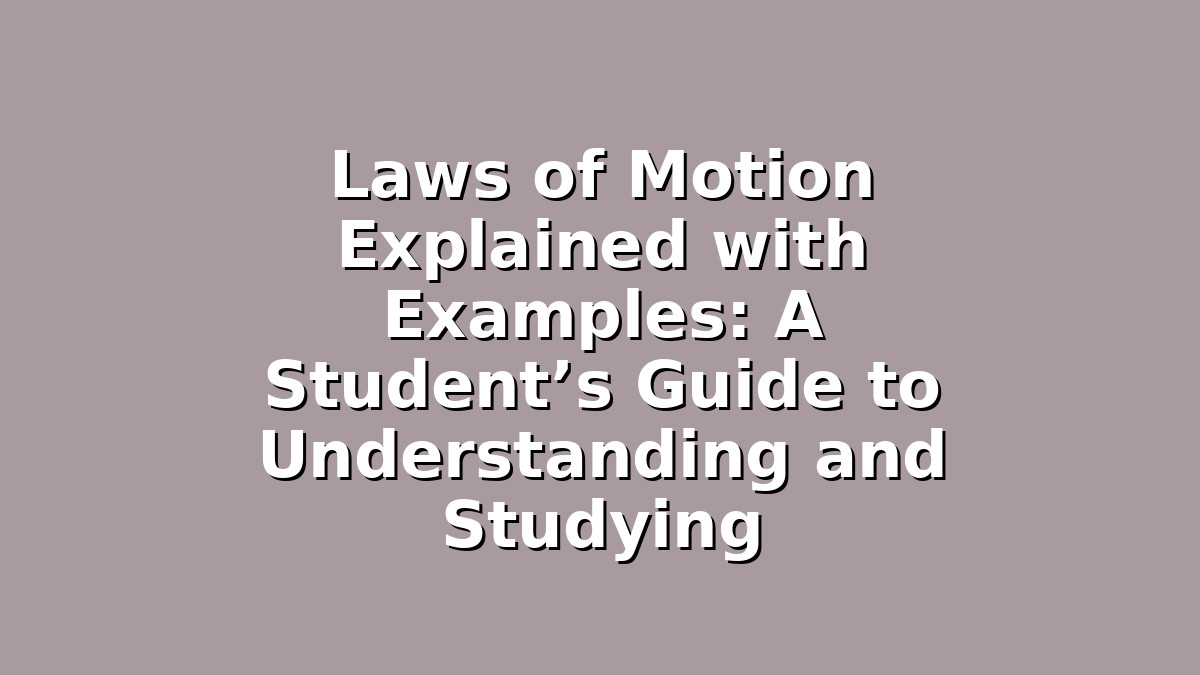If you’re a student preparing for exams in physics, one topic that you cannot ignore is the Laws of Motion. These fundamental principles, first formulated by Sir Isaac Newton, form the backbone of classical mechanics and often appear in various competitive and school-level exams. Understanding the Laws of Motion not only helps you score well but also builds a strong foundation for advanced physics concepts. This article will explain the three laws of motion in clear terms, provide practical examples, and share effective study tips to help you master the topic with confidence.
Introduction to the Laws of Motion
The Laws of Motion describe how objects behave when forces act on them. They explain why objects move, stop, or change direction and help us predict the outcomes of different physical situations. The three laws are:
1. Newton’s First Law (Law of Inertia)
2. Newton’s Second Law (Law of Acceleration)
3. Newton’s Third Law (Law of Action and Reaction)
Each law is simple to understand but can be applied in many complex scenarios. Let’s break down these laws with relatable examples and study strategies to help you grasp the concepts effectively.
—
1. Newton’s First Law of Motion: The Law of Inertia
What it says: An object at rest stays at rest, and an object in motion continues to move at a constant speed in a straight line unless acted upon by an external force.
Simple explanation: Things don’t start moving or stop moving on their own. They need a push or a pull (force) to change their state.
Example: Imagine a book lying on your study table. It won’t move unless you push it. Similarly, if a ball is rolling on the ground, it will eventually stop because of friction (which is an external force).
Study Tip:
To remember this law, associate it with daily life examples. Observe objects around you — like a bicycle that stops when you stop pedaling because of friction or a parked car that won’t move unless you start the engine. Drawing or visualizing these examples can help reinforce the concept.
How to study this law:
– Write down the law in your own words.
– Create flashcards with examples on one side and the law on the other.
– Solve previous exam questions that focus on inertia.
– Perform simple experiments at home, such as sliding a book across a table and noting when and why it stops.
—
2. Newton’s Second Law of Motion: The Law of Acceleration
What it says: The acceleration of an object is directly proportional to the net force acting on it and inversely proportional to its mass. Mathematically, it’s expressed as F = ma, where F is force, m is mass, and a is acceleration.
Simple explanation: The harder you push an object, the faster it speeds up. But if the object is very heavy, it will speed up more slowly.
Example: Suppose you try pushing an empty shopping cart versus a fully loaded one. You’ll notice the empty cart moves faster with the same push because it has less mass.
Study Tip:
Focus on understanding the formula F = ma, as it’s the key to solving many numerical problems. Practice rearranging the formula to solve for force, mass, or acceleration depending on the question.
How to study this law:
– Solve numerical problems regularly to build confidence.
– Use real-life scenarios to understand the relationship between force, mass, and acceleration.
– Try to derive the formula by thinking about how varying force and mass affect motion.
– Use online simulations or apps that demonstrate force and acceleration visually.
—
3. Newton’s Third Law of Motion: The Law of Action and Reaction
What it says: For every action, there is an equal and opposite reaction.
Simple explanation: When you push something, it pushes back with the same force.
Example: When you jump off a small boat onto a dock, the boat moves backward. Your action of pushing against the boat produces an equal and opposite reaction pushing the boat away.
Study Tip:
Remember this law by thinking of everyday interactions: walking (your feet push the ground backward, and the ground pushes you forward), or a rocket launch (exhaust gases push down, rocket moves up).
How to study this law:
– Draw diagrams illustrating action-reaction pairs.
– Practice identifying action-reaction pairs in different problems.
– Use physical activities or demonstrations to feel the action and reaction forces.
– Make a list of practical examples and try explaining them aloud as if teaching someone else.
—
Bonus Study Tips for Mastering the Laws of Motion
1. Use Visual Aids: Diagrams, flowcharts, and animations make abstract concepts easier to understand. Many websites offer free simulations related to Newton’s laws.
2. Group Study: Discussing concepts with friends helps clarify doubts and exposes you to different problem-solving methods.
3. Practice Past Papers: Applying your knowledge to past exam questions helps familiarize you with question patterns and time management.
4. Teach Someone Else: Explaining the laws to a peer or even to yourself can deepen your understanding.
5. Stay Consistent: Physics requires regular practice. Dedicate fixed time slots for revising and solving problems.
—
Conclusion
The Laws of Motion are fundamental principles that explain how objects move and interact with forces. Newton’s First Law introduces inertia, the reason objects resist changing their motion. The Second Law quantifies how force affects motion through acceleration, while the Third Law reveals the balance of forces in interactions. By linking these laws to everyday examples, experimenting, practicing problems, and using smart study techniques, you can master this topic easily and boost your physics scores.
Remember, physics is not just about memorizing formulas; it’s about understanding how the world works. Keep practicing, stay curious, and you’ll find the Laws of Motion an exciting and rewarding subject.
Good luck with your exams!

Responses